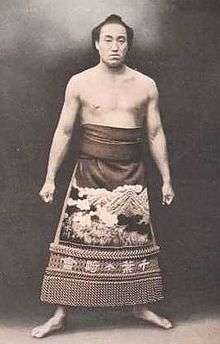Shimizugawa Motokichi
| Shimizugawa Motokichi | |
|---|---|
| 清水川元吉 | |
 | |
| Personal information | |
| Born |
Yonesaku Nagao 13 January 1900 Aomori, Japan |
| Died | 5 July 1967 (aged 67) |
| Height | 1.77 m (5 ft 9 1⁄2 in) |
| Weight | 97 kg (214 lb) |
| Career | |
| Stable | Hatachiyama |
| Record | 272-157-48-1draw-8holds |
| Debut | January 1917 |
| Highest rank | Ōzeki (May 1932) |
| Retired | May 1937 |
| Championships |
3 (Makuuchi) 2 (Jūryō) |
| * Up to date as of June 2008. | |
Shimizugawa Motokichi (13 January 1900 – 5 July 1967) was a sumo wrestler from Goshogawara, Aomori, Japan. His highest rank was ōzeki.
Career
Making his debut in January 1917, he was promoted to the top makuuchi division in January 1923 and made the fourth komusubi rank in January 1926, although he did not take part in that tournament. He competed in the maegashira ranks in 1927 but left the Japan Sumo Association temporarily and was not listed on the banzuke ranking sheets in the March and May 1928 tournaments. Returning in October 1928 he was listed at the bottom of the jūryō division and after winning two jūryō tournament titles he returned to the top division in 1930.
Shimizugawa was promoted to the second highest rank of ōzeki in 1932 but never made the highest yokozuna rank, despite winning a total of three top division tournament championships. He was overlooked for promotion while two men with inferior records to him, Musashiyama and Minanogawa, were both promoted to yokozuna instead. It has been suggested that this was because Shimizugawa belonged to a small stable, Hatachiyama, whereas Musashiyama and Minanogawa were both members of much larger and more influential stables (Dewanoumi and Takasago, respectively).[1]
Retirement from sumo
After finishing as runner-up in the May 1937 tournament, his fifth runner-up performance, Shimizugawa announced his retirement. He remained in the sumo world as an elder under the name Oitekaze Oyakata, and was head coach of the Oitekaze stable. Among the wrestlers he produced was a komusubi to whom he gave his old shikona or fighting name, Shimizugawa Akio.
Career Record
- In 1927 Tokyo and Osaka sumo merged and four tournaments a year in Tokyo and other locations began to be held.
| - | Spring Haru basho, varied |
Summer Natsu basho, varied |
|---|---|---|
| 1917 | (Maezumo) | (Maezumo) |
| 1918 | East Jonokuchi #25
3–2 |
East Jonidan #70
4–1 |
| 1919 | West Jonidan #17
3–1 1h |
East Sandanme #32
4–1 |
| 1920 | West Sandanme #3
4–1 |
East Makushita #28
2–2 1h |
| 1921 | East Makushita #26
3–1 1h |
East Makushita #19
3–1 1h |
| 1922 | East Jūryō #13
2–1 2h |
West Jūryō #3
4–3 |
| 1923 | West Maegashira #15
2–7 1h |
East Jūryō #4
6–3 |
| 1924 | West Maegashira #13
4–5 1h |
West Maegashira #12
4–7 |
| 1925 | West Maegashira #15
8–3 |
East Maegashira #5
8–2–1 1d |
| 1926 | East Komusubi #1
0–0–11 |
West Maegashira #4
8–3 |
| - | Spring Haru basho, Tokyo |
March Sangatsu basho, varied |
Summer Natsu basho, Tokyo |
October Jūgatsu basho, varied |
|---|---|---|---|---|
| 1927 | East Maegashira #1
3–8 |
East Maegashira #1
3–8 |
West Maegashira #7
0–0–11 |
East Maegashira #5
0–0–11 |
| 1928 | East Maegashira #12
0–0–11 |
Left JSA | Left JSA | Makushita #1
4–3 |
| 1929 | East Jūryō #12
8–3 |
East Jūryō #12
10–1 Champion |
West Jūryō #1
11–0 Champion |
West Jūryō #1
8–3 |
| 1930 | East Maegashira #8
6–5 |
East Maegashira #8
7–4 |
West Maegashira #3
3–8 |
West Maegashira #3
9–2 |
| 1931 | East Komusubi #1
5–6 |
East Komusubi #1
4–7 |
West Maegashira #3
10–1 |
West Maegashira #3
6–5 |
| 1932 | West Sekiwake #1
8–0 |
West Sekiwake #1
8–2 |
East Ōzeki #2
10–1 |
East Ōzeki #2
9–2 |
| - | Spring Haru basho, Tokyo |
Summer Natsu basho, Tokyo |
Autumn Aki basho, Tokyo |
|||
|---|---|---|---|---|---|---|
| 1933 | East Ōzeki #1
5–6 |
West Ōzeki #1
7–4 |
Not held | |||
| 1934 | West Ōzeki #1
7–4 |
West Ōzeki #1
11–0 |
Not held | |||
| 1935 | East Ōzeki #1
5–6 |
West Ōzeki #2
7–4 |
Not held | |||
| 1936 | West Ōzeki #1
4–7 |
West Ōzeki #1
6–5 |
Not held | |||
| 1937 | West Ōzeki #1
6–5 |
West Ōzeki #1
Retired 10–3 |
||||
| Record given as win-loss-absent Top Division Champion Retired Lower Divisions Key:d=Draw(s) (引分); h=Hold(s) (預り) | ||||||
See also
- Glossary of sumo terms
- List of sumo tournament top division champions
- List of past sumo wrestlers
- List of ōzeki
References
- ↑ Kuroda, Joe (October 2006). "Rikishi of Old:Minanogawa Tozo". Sumo Fan Magazine. Retrieved 2008-06-09.
- ↑ "Shimuzugawa Motokichi Rikishi Information". Sumo Reference. Retrieved 2013-06-11.